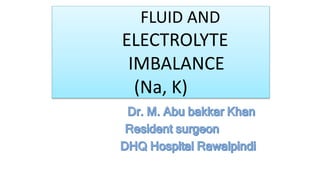This document discusses fluid and electrolyte imbalance, focusing on sodium and potassium. It begins by outlining where fluid is distributed in the body. It then discusses daily fluid intake and losses. Key points about sodium include that it maintains extracellular fluid balance, nerve impulse transmission, and is regulated by aldosterone and urine output. Causes, symptoms, and treatment of hyponatremia and hypernatremia are summarized. Regarding potassium, it notes its role in muscle function and that the kidney plays a dominant role in regulation. Causes, symptoms, and ECG changes of hypokalemia are outlined.











![Hyponatremia
• defined as a serum [Na+] <135 mmol/L
• one of the most common electrolyte abnormalities encountered
in hospitalized pts
• Symptoms include nausea, vomiting, confusion, lethargy, and
disorientation
• if severe (<120 mmol/L) and/or abrupt, seizures, central
herniation, coma, or death may result
• Clinical manifestations primarily have a central nervous system
origin and are related to cellular water intoxication and
associated increases in intracranial pressure](https://image.slidesharecdn.com/electrolytes-190610164603/85/Electrolytes-12-320.jpg)





























